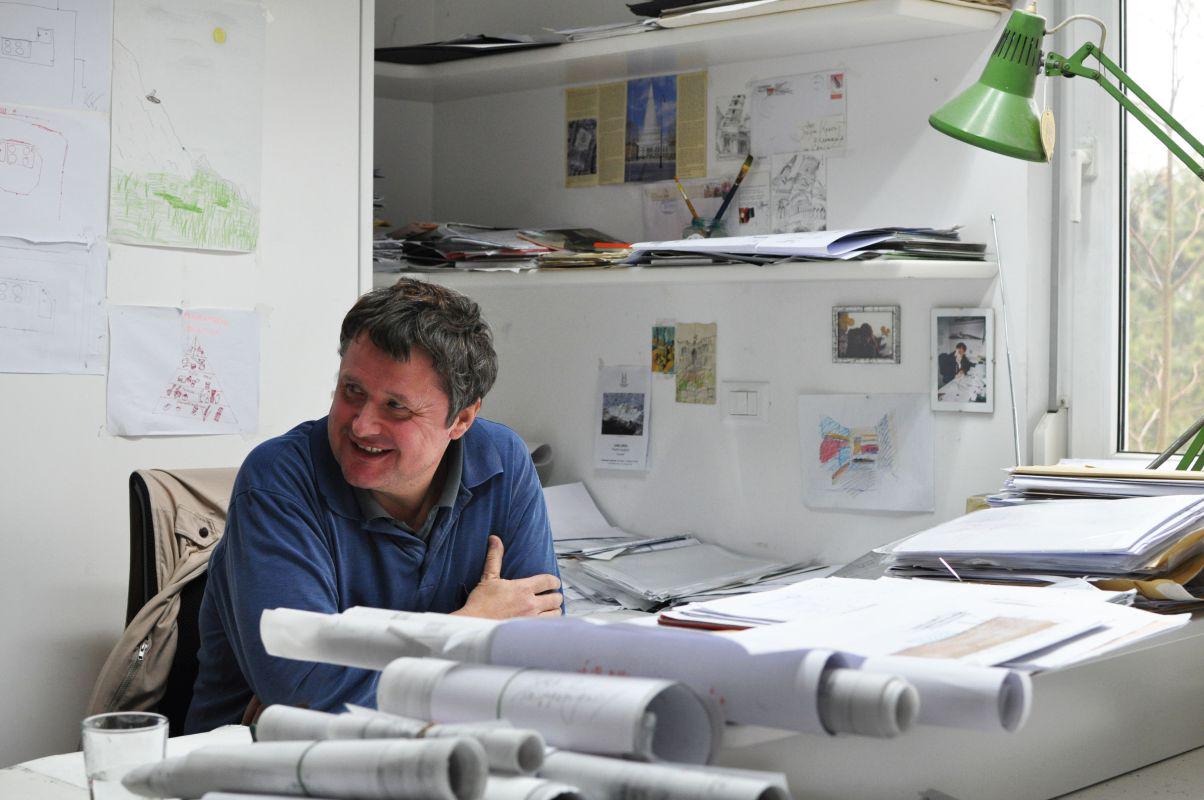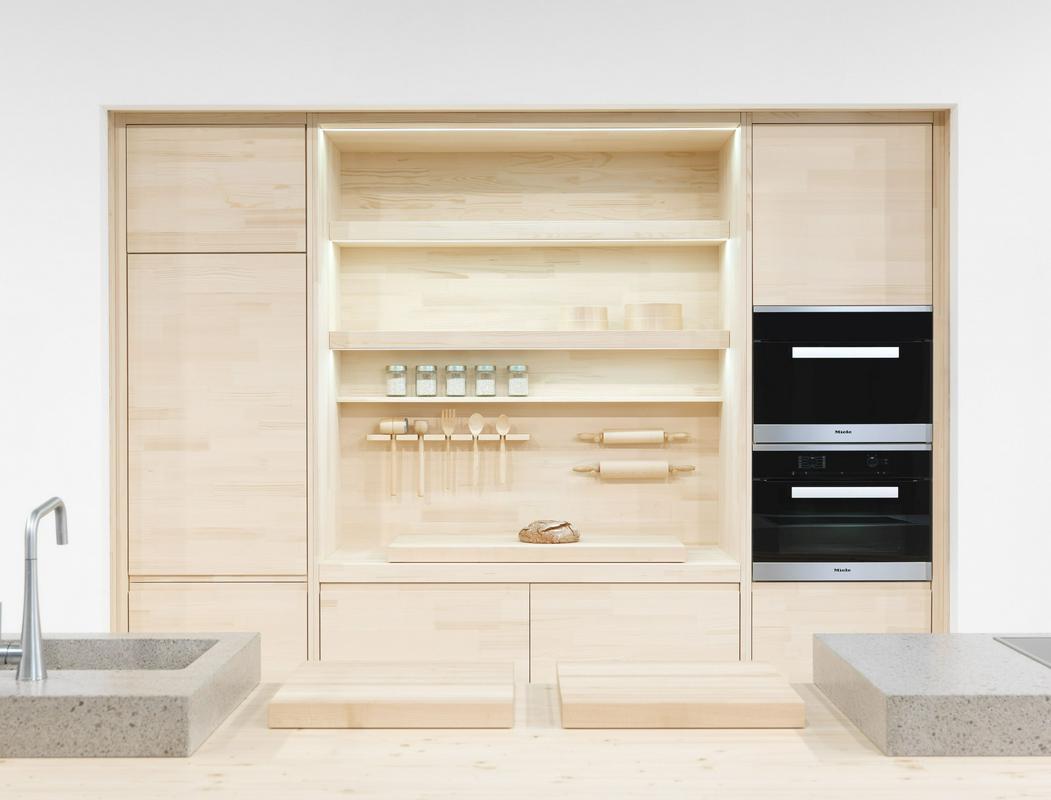
Julijan Krapež graduated from the Faculty of Architecture in Ljubljana under Professor Janez Suhadolc. He continued his studies at the Venice Faculty of Architecture. He has become renowned primarily as a furniture designer. For a number of years he worked as a designer for the Ajdovščina Furniture Factory. He works as a freelance designer; in 1991, he started to combine his design solutions with the technical knowledge of Potočnik Furniture, a company which was also involved in the Spruce and Terrazzo Kitchen production.

He designed a Spruce and Terrazzo Kitchen in collaboration with Potočnik Furniture, and it won him four prizes and awards at the Ambient Ljubljana–Furniture Fair. To date, nobody has gained so many awards for a single product. This success is purely Slovenian and here the story begins of an engaging challenge.
The award-winning and admired Spruce and Terrazzo Kitchen is primarily distinguished for successfully integrating Slovenian tradition and the use of wood and stone. Traditions of home environment, Slovenia, provide a starting point and emanate from the work of designer Julian Krapež.
Wood as a symbol of Slovenia
Spruce and Terrazzo Kitchen is made of a spruce and ground concrete terrazzo, the material much used by the Slovenian architect Jože Plečnik. Krapež designed this mid-priced kitchen in pursuit of bringing design furniture as close as possible to a wider audience in Slovenia and elsewhere. But this has not been his only objective: "Basically, it is about designing in wood, which has an ancient tradition in Slovenia. Of all different types of wood I should mention walnut and lime. The latter is also a symbol of the Slovenian nation. Lime-wood used to be most widely utilised, primarily in churches. I also love to work with elm, which has become scarce in Slovenian forests. From a designer’s point of view, mountain maple and oak are also interesting. I hope our customers buy the furniture I design together with Potočnik Furniture also because of the high quality of Slovenian wood. Spruce is a very useful though low price wood, which may be the reason for the somewhat dismissive attitude towards it."
Gourmet pantries and places
"I believe I can create a world-class design and produce a bestseller through the added content value drawn from the Slovenian tradition. Besides being an ensemble of individual units, furniture should also be rich in its content. That is why I added a bread cradle (mentrga or vintla) to the kitchen’s cooking unit," the Slovenian architect explains. A bread cradle is a wooden basin with a lid used by the housewives at the end of the 19th century for storing flour and kneading dough, the lid was used for its rolling. This is the starting point of a furniture revolution as planned by Krapež: "It is my vision that the furniture user will no longer store all things in one cupboard but will distribute them to separate individual components. These components may incorporate parts of furniture embracing Slovenian methods of making sausages, spirits, storing meat, etc. This includes items familiar to us from Slovenian tradition but no longer used in daily life. We can humorously name them "gourmet pantries and places". This is our wealth, by appropriately promoting this story we can achieve great success in foreign markets. Hence, Krapež furniture gives flavour to the form and form to the flavour. Krapež admits that in terms of content his idea translates into a very demanding project which will in the future include not only a designer and furniture maker but will also demand cooperation with an ethnologist, ethnographer, and a historian.
He is obviously talking about those individual customers who are not satisfied with mass-produced goods but value the quality of wood and form. Indeed, in most cases customers furnish the newly built dwelling units or houses of historical value, but Krapež does not forget apartment buildings: "Functionality with the same content is also a challenge. A modern design with traditional elements." At present, Krapež and Potočnik Furniture unique sets are only produced as ensembles and not as individual components, but this type of production is included in their short-term plan. "Components like the bread cradle can be a perfect accessory to industrially produced furniture. It is, of course, more perfect if the entire component is unique; nonetheless, these traditional elements for bread making, sausage drying, cured meats, spirits and wine storing, etc. are a content-rich piece of furniture. The most important thing is that we not only design furniture produced in Slovenia but also made of Slovenian wood, conveying a message about Slovenians. That part of this line is also offered at prices affordable to a wider range of customers."
Personal approach and technological perfection
The style of furniture by Krapež, primarily of the kitchens he started to design in 2009, draws on fine arts principles and places an explicit emphasis on the basic materials: wood and stone. "I very much like to use this combination. In this, I am inspired by Plečnik; I also greatly value my professor, architect Janez Suhadolc. There are fewer and fewer quarries in Slovenia, but you can still find some. There is beautiful stone found in Slovenia, for example Karst natural stone, Lesno Brdo limestone and Hotavlje marble."
Julijan Krapež and Potočnik Furniture tandem is intrigued by design’s individuality achieved through personal approach and technical perfection. "We pay particular attention to details and joints which have an important aesthetic function." Krapež points out: "I would like to devote even more attention to explicit statuary and painting details reflecting Slovenian tradition, of course. I would include them into the furniture components in expected or completely unexpected ways. You open a drawer and see a painting. I’m also attracted by the idea of a furniture ensemble incorporating not only the Slovenian tradition of furniture components, but also “drawers full of Slovenian utensils (for example rolling pin). I also find ecological awareness very important. The world is drowning in hyper-production, artificial materials and processing. I promote ecological oiling and waxing; if varnish is used, it must be water-based. Why would a glowing brilliance be needed? I myself find nothing wrong with a cut or drop I notice while sitting at a table. They speak about the life of the people under the roof sheltering this table."
Slovenia cannot be overlooked
The rooms furnished with such kitchens and such furniture have souls. Designers like Krapež aspire to entice wood and stone to mirror the Slovenian soul. I am convinced that their vision will also be recognised when they enter foreign markets. Slovenia has excellent wood, quality stone and, according to Julijan Krapež, many good designers. Slovenia is a beautiful, unique and special country. Its green and diverse environment imbued with a warm sense of spirituality can hardly be overlooked.
Tanja Glogovčan, SINFO
Julijan Krapež graduated from the Faculty of Architecture in Ljubljana under Professor Janez Suhadolc. He continued his studies at the Venice Faculty of Architecture. He has become renowned primarily as a furniture designer. For a number of years he worked as a designer for the Ajdovščina Furniture Factory. He works as a freelance designer; in 1991, he started to combine his design solutions with the technical knowledge of Potočnik Furniture, a company which was also involved in the Spruce and Terrazzo Kitchen production.

































































